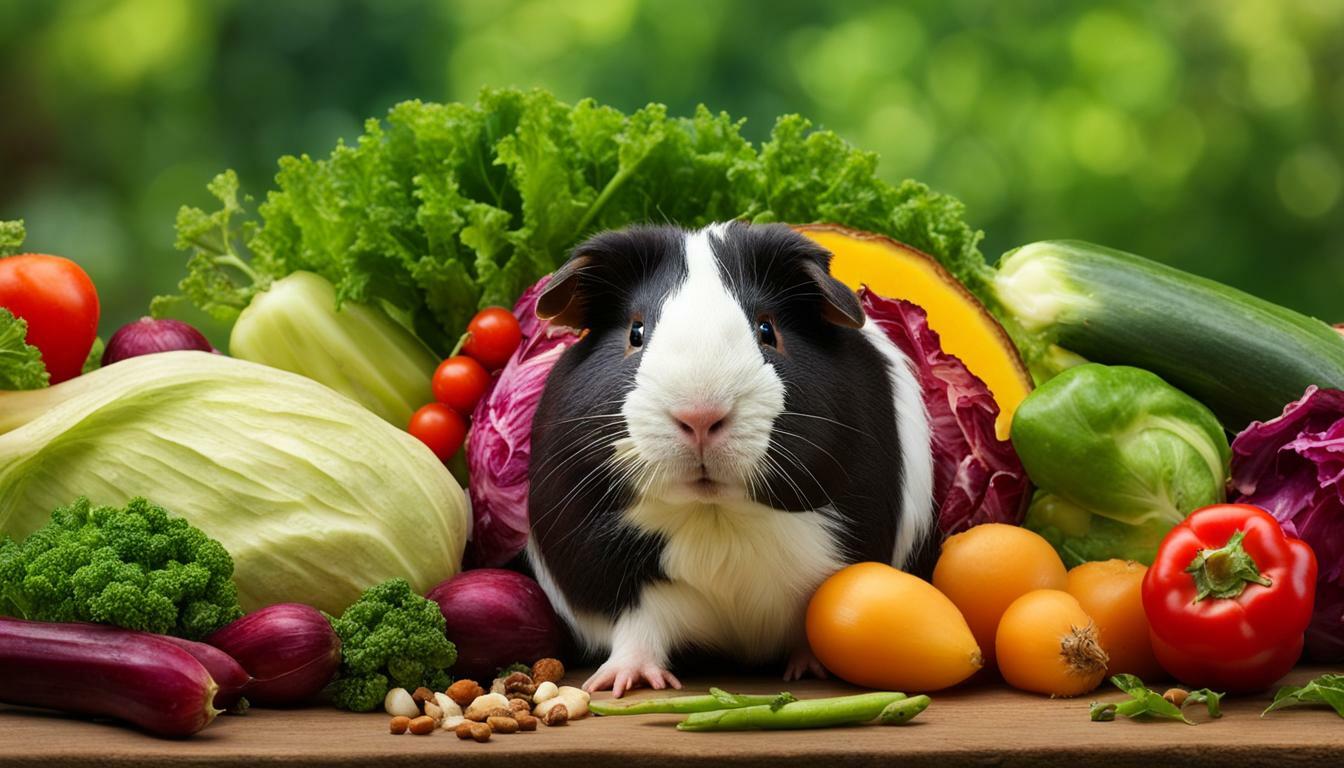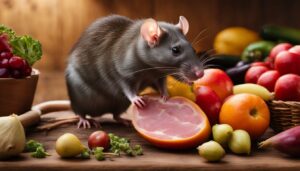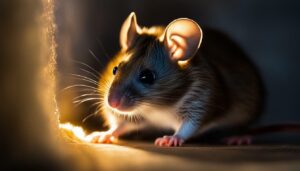Guinea pigs make great pets, but their diet requires careful consideration. One question that often arises is whether or not they can eat radicchio.
Key Takeaways:
- Radicchio can be safely fed to guinea pigs in moderation.
- It is a good source of vitamins and minerals, including potassium, vitamin K, and antioxidants.
- Radicchio should not be fed daily due to its high phosphorus and oxalate content.
- Guinea pigs should be given small amounts 2-3 times a week.
- Radicchio lacks sufficient vitamin C, so it should be balanced with other high vitamin C vegetables.
Radicchio is generally enjoyed by guinea pigs, but it can be a bit bitter for some. It is recommended to serve raw, uncooked radicchio and avoid feeding cooked or wilted leaves. Introducing radicchio to a guinea pig’s diet should be done slowly and any signs of digestive upset should be monitored closely. By following these guidelines, you can safely incorporate radicchio into your guinea pig’s diet, providing them with a variety of nutrients and flavors.
Nutritional Benefits of Radicchio for Guinea Pigs
Radicchio is rich in nutrients, making it a potentially healthy addition to a guinea pig’s diet. It is packed with vitamins, minerals, and antioxidants that can support their overall well-being. One of the key nutrients found in radicchio is potassium, which plays a vital role in maintaining healthy bodily functions in guinea pigs.
Vitamin K is another essential nutrient found in radicchio. This vitamin helps with blood clotting and can contribute to the proper development and maintenance of guinea pigs’ bones. Additionally, radicchio contains antioxidants that can help protect their cells from damage caused by harmful free radicals.
While radicchio offers several nutritional benefits, it should not be fed to guinea pigs on a daily basis. This is because radicchio contains high levels of phosphorus and oxalates, which can be detrimental to their health if consumed in large quantities. To ensure the well-being of your guinea pig, it is recommended to feed small amounts of radicchio 2-3 times a week.
Since radicchio lacks sufficient vitamin C, it is important to balance its inclusion in their diet with other vegetables that are high in this essential nutrient. Guinea pigs require vitamin C to prevent scurvy, a condition that can lead to weakness, bruising, and other health issues. Watching for signs of digestive upset when introducing radicchio is also crucial, as each guinea pig’s tolerance can vary.
| Vitamins | Minerals | Antioxidants |
|---|---|---|
| Vitamin K | Potassium | Protective Antioxidants |
| Essential for blood clotting and bone health | Important for healthy bodily functions | Helps protect cells from damage |
Guinea pigs generally enjoy the taste of radicchio, but it can be slightly bitter for some. It is best to serve radicchio in its raw, uncooked form to retain its nutritional value. Avoid feeding cooked or wilted leaves to ensure your guinea pig gets the maximum benefit from this leafy vegetable. By incorporating radicchio into their diet in moderation and taking these precautions, you can provide your furry friend with a varied and nutritious meal.
Recommended Feeding Frequency of Radicchio for Guinea Pigs
While radicchio can be beneficial for guinea pigs, it should be fed in moderation and according to specific recommendations. This delicious leafy vegetable is packed with essential vitamins and minerals, such as potassium and vitamin K, and is also rich in antioxidants that support overall health.
However, due to its high phosphorus and oxalate content, it is important to avoid overfeeding radicchio to guinea pigs. Excessive consumption of these nutrients can lead to health issues such as bladder stones or urinary tract complications. Therefore, it is best to offer small amounts of radicchio to your furry friends 2-3 times a week.
Since radicchio lacks sufficient vitamin C, a vital nutrient for guinea pigs, it is crucial to balance it with other vegetables that are high in vitamin C. Vegetables like bell peppers, kale, and parsley are excellent choices to complement the nutritional needs of your guinea pig.
When introducing radicchio to your guinea pig’s diet, it is recommended to start with small quantities and gradually increase the amount over time. This will allow their digestive system to adapt and minimize the risk of digestive upset. Keep a close eye on your guinea pig and monitor their response to radicchio to ensure they tolerate it well.
| Radicchio Feeding Recommendations for Guinea Pigs |
|---|
| Feed small amounts of radicchio |
| 2-3 times a week |
| Balance with other high vitamin C vegetables |
| Introduce gradually and monitor for digestive upset |
| Serve raw, uncooked radicchio |
| Avoid feeding cooked or wilted leaves |
Although guinea pigs generally enjoy radicchio, it is important to note that some may find it a bit bitter. It might take a few tries for them to develop a taste for it, so don’t be discouraged if they initially show less interest. Remember to serve radicchio in its raw and uncooked form to preserve its nutritional benefits.
Potential Risks of Radicchio for Guinea Pigs
Despite its nutritional benefits, radicchio should be given to guinea pigs with caution due to potential risks. While radicchio contains essential vitamins, minerals, and antioxidants that can support a guinea pig’s overall health, its high phosphorus and oxalate content can pose challenges if fed excessively.
The high levels of phosphorus in radicchio can lead to imbalances in a guinea pig’s calcium-to-phosphorus ratio, potentially contributing to urinary tract issues, such as the formation of bladder stones. To avoid these risks, it is important to feed radicchio in moderation and ensure a well-balanced diet that includes other calcium-rich foods.
Additionally, radicchio contains oxalates, which can bind with calcium in the body, potentially forming calcium oxalate crystals or stones. To minimize the risks associated with oxalates, it is recommended to provide radicchio 2-3 times a week in small amounts, alongside other vegetables that are low in oxalates.
When introducing radicchio to a guinea pig’s diet, it is crucial to do so gradually. Start by offering a small piece and observe the guinea pig’s response. Watch for any signs of digestive upset, such as diarrhea or a decrease in appetite. If any adverse reactions occur, discontinue feeding radicchio immediately and consult a veterinarian.
Table: Potential Risks of Radicchio for Guinea Pigs
| Potential Risks | Precautions |
|---|---|
| Imbalances in calcium-to-phosphorus ratio | Feed radicchio in moderation and ensure a well-balanced diet |
| Formation of bladder stones | Monitor calcium levels and provide other calcium-rich foods |
| Formation of calcium oxalate crystals or stones | Feed radicchio in small amounts alongside low-oxalate vegetables |
| Digestive upset | Introduce radicchio gradually and monitor for any adverse reactions |
It is important to note that while some guinea pigs may enjoy the taste of radicchio, others may find it too bitter. As with any new food, it may take time for guinea pigs to develop a preference for radicchio. To enhance acceptance, try mixing it with other leafy greens or vegetables that the guinea pig already enjoys.
Remember, when serving radicchio to guinea pigs, it should always be given raw and uncooked. Avoid feeding cooked or wilted leaves, as they may lose some of their nutritional value and potentially present digestion-related risks.
By understanding and mitigating the potential risks associated with radicchio, guinea pig owners can incorporate this leafy green into their pets’ diet in a safe and balanced manner, enriching their nutritional variety while prioritizing their well-being.
Balancing Radicchio with Other Vegetables in a Guinea Pig’s Diet
As radicchio lacks sufficient vitamin C, it should be combined with other vegetables to meet a guinea pig’s nutritional needs. While radicchio can provide valuable vitamins and minerals, including potassium and vitamin K, it is important to ensure a well-rounded diet for your furry friend.
To balance the nutritional intake, consider incorporating other vegetables that are high in vitamin C, such as bell peppers, kale, or parsley, into your guinea pig’s diet. These vegetables can help fulfill their vitamin C requirements, as guinea pigs cannot synthesize this essential nutrient on their own.
When introducing radicchio to your guinea pig’s diet, start gradually. Begin by offering small portions of radicchio alongside their regular vegetables. This will allow their digestive system to adjust and minimize the risk of any digestive upset.
It’s important to note that while some guinea pigs may develop a preference for radicchio due to its slightly bitter taste, others may take time to acquire the taste. Be patient and observe your guinea pig’s reaction to determine their preference.
Table 1: Examples of Vegetables High in Vitamin C
| Vegetable | Vitamin C content (per 100g) |
|---|---|
| Bell peppers (red) | 127.7mg |
| Kale | 120mg |
| Parsley | 133mg |
Remember, radicchio should be served raw and uncooked to preserve its nutritional value. Avoid feeding cooked or wilted leaves, as they may lose some of their beneficial properties.
By balancing radicchio with other vegetables high in vitamin C, you can ensure that your guinea pig receives a well-rounded and nutritious diet. Remember to monitor their overall health and consult with a veterinarian for any specific dietary recommendations.
Introducing Radicchio to a Guinea Pig’s Diet
When introducing radicchio to a guinea pig’s diet, it’s important to do so slowly and observe their reactions. Guinea pigs have sensitive digestive systems, and sudden dietary changes can cause upset stomach or diarrhea. Start by offering a small amount of radicchio, about one or two leaves, and monitor how your guinea pig responds.
Some guinea pigs may take to radicchio immediately, while others may need time to adjust to the slightly bitter taste. If your guinea pig shows signs of disinterest, don’t be discouraged. You can try offering radicchio mixed with their favorite vegetables or gradually increase the amount over time.
Monitoring Digestive Upset
During the introduction phase, it’s crucial to pay attention to any signs of digestive upset. Watch for changes in stool consistency, excessive gas, or decreased appetite. If you notice any of these symptoms, it’s best to discontinue feeding radicchio and consult a veterinarian for further guidance.
To maintain a balanced diet for your guinea pig, it’s important to include other high vitamin C vegetables alongside radicchio. Bell peppers, kale, and parsley are excellent choices that can provide the necessary vitamin C boost. Remember to chop all vegetables into bite-sized pieces to prevent choking hazards.
| Vitamin | Amount (per 100g) |
|---|---|
| Vitamin K | 255.2 mcg |
| Potassium | 302 mg |
| Phosphorus | 40 mg |
| Oxalate | 413 mg |
Remember, radicchio should be served to guinea pigs raw and uncooked. Cooking can reduce its nutritional value and make it less appealing to your furry friend. By following these guidelines, you can safely incorporate radicchio into your guinea pig’s diet and provide them with a variety of flavors and nutrients.
Guinea Pig Preference for Radicchio
Many guinea pigs enjoy the taste of radicchio, although it may take some time for them to develop a liking for it. This leafy vegetable provides a unique flavor that can be a bit bitter for some, but once acquired, it becomes a favorite treat for many furry friends.
When introducing radicchio to your guinea pig’s diet, it is essential to start with small quantities and gradually increase the amount. This allows their taste buds to adjust to the distinct flavor and prevents any digestive upset. Remember, every guinea pig is different, so while some might immediately take a liking to radicchio, others may need more time to warm up to it.
It’s important to note that radicchio should not be the sole vegetable in a guinea pig’s diet. Since it lacks sufficient vitamin C, which is vital for their health, it should be served alongside other vegetables high in this essential nutrient. A balanced diet ensures that your guinea pig receives all the necessary vitamins and minerals they need to thrive.
| Guinea Pig Diet Tips |
|---|
| Introduce radicchio gradually to avoid digestive upset. |
| Combine radicchio with other high vitamin C vegetables for a well-rounded diet. |
| Feed radicchio in moderation, 2-3 times a week, due to its high phosphorus and oxalate content. |
| Avoid feeding cooked or wilted radicchio leaves; serve it raw and uncooked. |
- Introduce radicchio gradually to avoid digestive upset.
- Combine radicchio with other high vitamin C vegetables for a well-rounded diet.
- Feed radicchio in moderation, 2-3 times a week, due to its high phosphorus and oxalate content.
- Avoid feeding cooked or wilted radicchio leaves; serve it raw and uncooked.
Serving Recommendations for Radicchio to Guinea Pigs
To ensure the optimal nutritional benefits, it is best to serve radicchio to guinea pigs raw and avoid offering cooked or wilted leaves. Guinea pigs require fresh and unprocessed foods to maintain their health, and radicchio is no exception. Raw radicchio retains its natural vitamins, minerals, and antioxidants, providing a wholesome addition to their diet.
When offering radicchio to your guinea pigs, it is important to introduce it gradually. Begin by providing small amounts of shredded or chopped radicchio, alongside their regular diet. Monitor your guinea pigs closely for any signs of digestive upset, such as diarrhea or stomach discomfort. If they tolerate it well, you can gradually increase the portion size.
Radicchio should be given to guinea pigs in moderation, typically 2-3 times a week. This frequency helps prevent the potential health risks associated with its high phosphorus and oxalate content. While radicchio is a good source of vitamins and minerals, it lacks sufficient amounts of vitamin C, vital for guinea pigs’ health. Therefore, it is essential to balance radicchio with other vegetables high in vitamin C, such as bell peppers, kale, or broccoli.
While guinea pigs generally enjoy the taste of radicchio, it can be a bit bitter for some. It may take some time for them to develop a preference for it. If your guinea pig does not immediately take to radicchio, you can try serving it alongside guinea pig favorites like carrots or cucumbers to encourage acceptance. Remember, each guinea pig has unique taste preferences, so it is essential to observe their reactions and adjust accordingly.
| Radicchio Serving Recommendations for Guinea Pigs: |
|---|
| Serve raw and uncooked radicchio |
| Introduce gradually and monitor for digestive upset |
| Feed in moderation, 2-3 times a week |
| Balance with other high vitamin C vegetables |
| Offer alongside guinea pig favorites to encourage acceptance |
By following these serving recommendations, you can safely incorporate radicchio into your guinea pig’s diet, providing them with variety and essential nutrients. Remember to always consult with a veterinarian before making any significant changes to your guinea pig’s diet.
Conclusion
In conclusion, guinea pigs can safely eat radicchio as part of a balanced diet, but it should be offered in small amounts and not on a daily basis. Radicchio is a good source of vitamins and minerals, such as potassium and vitamin K, and contains antioxidants that can benefit guinea pigs. However, it is important to note that radicchio should not be fed daily due to its high phosphorus and oxalate content, which can be detrimental to guinea pig health if consumed excessively.
Guinea pigs should be given radicchio 2-3 times a week in order to avoid any potential health risks. Since radicchio lacks sufficient vitamin C, it is crucial to balance its consumption with other vegetables that are high in this essential nutrient. This will ensure that guinea pigs receive a well-rounded and nutritionally complete diet.
When introducing radicchio to a guinea pig’s diet, it is recommended to do so gradually. This will allow their digestive system to adjust and minimize the risk of any digestive upset. Additionally, it is worth noting that while many guinea pigs enjoy the taste of radicchio, some may find it too bitter. Therefore, it may take time for them to acquire a taste for it.
It is important to serve radicchio to guinea pigs in its raw and uncooked form. Cooked or wilted leaves should be avoided as they may lose some of their nutritional value and could potentially be harmful to guinea pigs. By following these guidelines, guinea pig owners can safely incorporate radicchio into their pets’ diet, providing them with a varied and enjoyable dining experience.
FAQ
Can guinea pigs eat radicchio?
Yes, guinea pigs can safely eat radicchio in moderation.
What are the nutritional benefits of radicchio for guinea pigs?
Radicchio is a good source of vitamins and minerals, including potassium, vitamin K, and antioxidants.
How often should radicchio be fed to guinea pigs?
Guinea pigs should be given small amounts of radicchio 2-3 times a week.
Are there any potential risks of feeding radicchio to guinea pigs?
Radicchio has a high phosphorus and oxalate content, so it should not be fed daily to guinea pigs.
How should radicchio be balanced with other vegetables in a guinea pig’s diet?
Radicchio lacks sufficient vitamin C, so it should be balanced with other high vitamin C vegetables.
How should radicchio be introduced to a guinea pig’s diet?
Radicchio should be introduced slowly to a guinea pig’s diet, watching for any signs of digestive upset.
Do guinea pigs generally enjoy radicchio?
Yes, guinea pigs generally enjoy radicchio, although it can be a bit bitter for some.
How should radicchio be served to guinea pigs?
It is recommended to serve raw, uncooked radicchio and avoid feeding cooked or wilted leaves.




